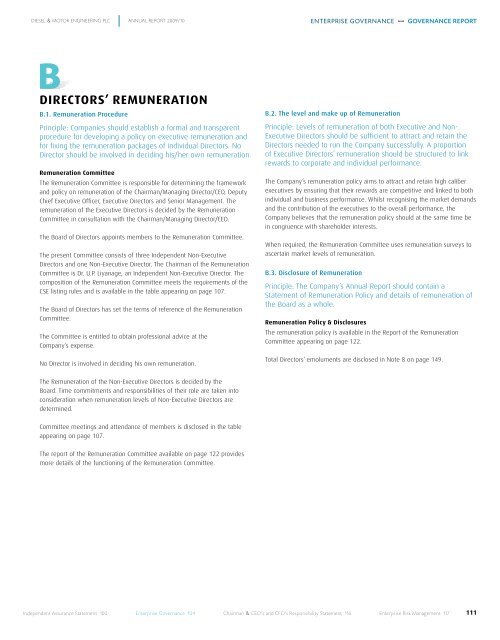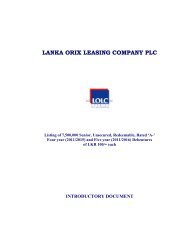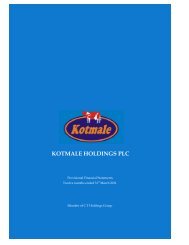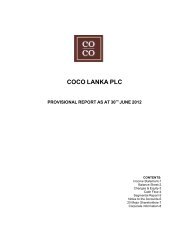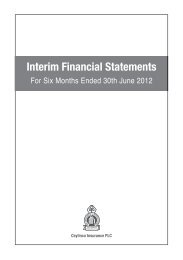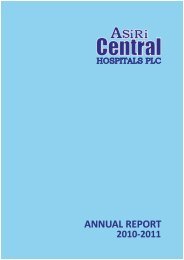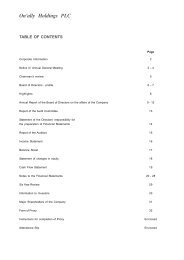directors - Colombo Stock Exchange
directors - Colombo Stock Exchange
directors - Colombo Stock Exchange
Create successful ePaper yourself
Turn your PDF publications into a flip-book with our unique Google optimized e-Paper software.
DIESEL & MOTOR ENGINEERING PLC ANNUAL REPORT 2009/10<br />
DIRECTORS’ REMUNERATION<br />
B.1. Remuneration Procedure<br />
Principle: Companies should establish a formal and transparent<br />
procedure for developing a policy on executive remuneration and<br />
for fixing the remuneration packages of individual Directors. No<br />
Director should be involved in deciding his/her own remuneration.<br />
Remuneration Committee<br />
The Remuneration Committee is responsible for determining the framework<br />
and policy on remuneration of the Chairman/Managing Director/CEO, Deputy<br />
Chief Executive Officer, Executive Directors and Senior Management. The<br />
remuneration of the Executive Directors is decided by the Remuneration<br />
Committee in consultation with the Chairman/Managing Director/CEO.<br />
The Board of Directors appoints members to the Remuneration Committee.<br />
The present Committee consists of three Independent Non-Executive<br />
Directors and one Non-Executive Director. The Chairman of the Remuneration<br />
Committee is Dr. U.P. Liyanage, an Independent Non-Executive Director. The<br />
composition of the Remuneration Committee meets the requirements of the<br />
CSE listing rules and is available in the table appearing on page 107.<br />
The Board of Directors has set the terms of reference of the Remuneration<br />
Committee.<br />
The Committee is entitled to obtain professional advice at the<br />
Company’s expense.<br />
No Director is involved in deciding his own remuneration.<br />
The Remuneration of the Non-Executive Directors is decided by the<br />
Board. Time commitments and responsibilities of their role are taken into<br />
consideration when remuneration levels of Non-Executive Directors are<br />
determined.<br />
Committee meetings and attendance of members is disclosed in the table<br />
appearing on page 107.<br />
The report of the Remuneration Committee available on page 122 provides<br />
more details of the functioning of the Remuneration Committee.<br />
e n t e r p r i s e g ov e r n a n C e goVernance report<br />
B.2. The level and make up of Remuneration<br />
Principle: Levels of remuneration of both Executive and Non-<br />
Executive Directors should be sufficient to attract and retain the<br />
Directors needed to run the Company successfully. A proportion<br />
of Executive Directors’ remuneration should be structured to link<br />
rewards to corporate and individual performance.<br />
The Company’s remuneration policy aims to attract and retain high caliber<br />
executives by ensuring that their rewards are competitive and linked to both<br />
individual and business performance. Whilst recognising the market demands<br />
and the contribution of the executives to the overall performance, the<br />
Company believes that the remuneration policy should at the same time be<br />
in congruence with shareholder interests.<br />
When required, the Remuneration Committee uses remuneration surveys to<br />
ascertain market levels of remuneration.<br />
B.3. Disclosure of Remuneration<br />
Principle: The Company’s Annual Report should contain a<br />
Statement of Remuneration Policy and details of remuneration of<br />
the Board as a whole.<br />
Remuneration Policy & Disclosures<br />
The remuneration policy is available in the Report of the Remuneration<br />
Committee appearing on page 122.<br />
Total Directors’ emoluments are disclosed in Note 8 on page 149.<br />
Independent Assurance Statement 100 Enterprise Governance 104 Chairman & CEO’s and CFO’s Responsibility Statement 116 Enterprise Risk Management 117<br />
111


